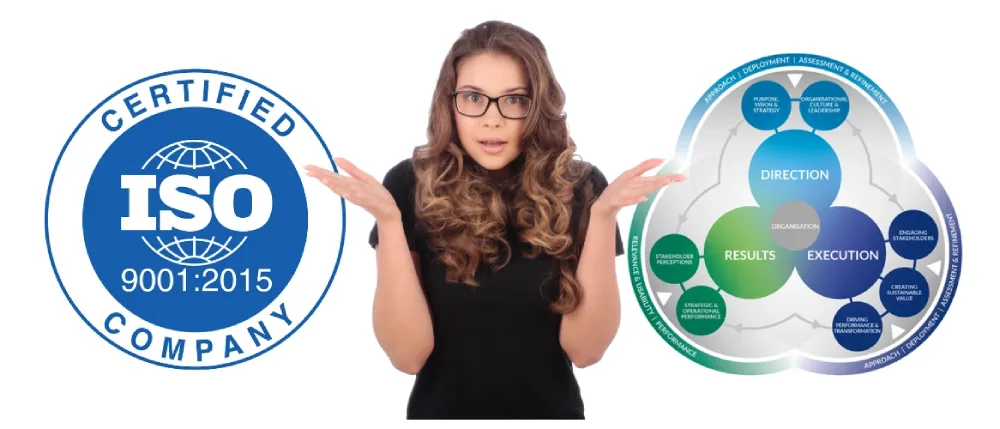Truly excellent organizations are those that strive to satisfy their stakeholders by what they achieve, and how they achieve it.
This process is not easy even in the best of the times. Sustaining success, in a world of increasing global competition, rapid technological innovation, changing processes and frequent movement in the economic, social and customer environments, is even more difficult.
Recognizing this challenge, the European Foundation for Quality Management (EFQM) has created world-class approaches to the management of organizations that would lead to sustainable excellence.
The EFQM Excellence Model is the primary framework for assessing and improving organizations, in order for them to achieve a sustainable advantage. This Model is based upon several Fundamental Principles of Excellence some of which are presented below. The rest of the principles will be presented in our next article.
Principle #1: Results Orientation: Excellence is achieving results that delight the organization’s all stakeholders.
Practical application of the Principle: In today’s fast-changing environment, excellent organizations are those that are receptive to new ideas, are flexible and responsive to changing stakeholder needs and expectations, and are able to adapt quickly to new conditions.
Excellent organizations measure and anticipate the needs and expectations of their stakeholders, monitor their experiences and perceptions, and monitor and review the performance of other organizations. Information is gathered from both current and future stakeholders. This information is used to set, implement and review their policies, strategies, objectives, targets, measures and plans, for the short, medium and longer term. The gathered information also helps the organization to develop and achieve a balanced set of stakeholder results.
Benefits: Application of this principle brings added value and sustainable success for all stakeholders. It helps in understanding of the current and future requirements for high performance and for setting realistic targets. It also brings alignment and focus throughout the organization, and as a result, delighted stakeholders.

Principle #2: Customer Focus: Excellence is creating sustainable customer value.
Practical application of the Principle: Excellent organizations know and intimately understand their customers. They understand that customers are the final judges of their product and service quality. They also understand that customer loyalty, retention and gaining market share are maximized through a clear focus on the needs and expectations of both existing and potential customers. Therefore, they are responsive to the customers’ needs and expectations. Where appropriate, they segment their customers to improve the effectiveness of their response. They monitor competitor activity and understand their competitive advantage. They effectively anticipate what customers’ future needs and expectations will be and act now in order to meet and where possible exceed them. They monitor and review the experiences and perceptions of their customers and wherever things go wrong, they respond quickly and effectively. They build and maintain excellent relationships with all their customers.
Benefits: Application of this principle results in delighted customers and strong customer loyalty and retention. It also results in enhanced market share and sustained success for the organization. It also motivates the organization’s employees and helps in understanding of the organization’s competitive advantage.
Principle #3: Leadership and Consistency of Purpose: Excellence is visionary and inspirational leadership, coupled with consistency of purpose.
Practical application of the Principle: Excellent organizations have leaders who set and communicate a clear direction for their organization. In doing so they unite and motivate other leaders to inspire their people. They establish values, ethics, culture and a governance structure for the organization that provide a unique identity and attractiveness to stakeholders. Leaders at all levels within these organizations constantly drive and inspire others towards excellence and in doing so, display both role model behavior and performance. They lead by example, recognizing their stakeholders and working with them on joint improvement activity. During times of turbulence they display a consistency of purpose and steadiness that inspires the confidence and commitment of their stakeholders. At the same time, they demonstrate the capability to adapt and realign the direction of their organization in the light of a fast moving and constantly changing external environment, and in so doing carry their people with them.
Benefits: Application of this principle brings clarity of purpose and direction within the organization, as well as a clear identity for, and within, the organization. It creates a shared set of values and ethics. It also creates consistent and role model behaviors throughout the organization thus creating a committed, motivated and effective workforce. All these result in confidence in the organization’s success, even in turbulent and changing times.
Principle #4: Management by Processes and Facts: Excellence is managing the organization through a set of interdependent and interrelated systems, processes and facts.
Practical application of the Principle: Excellent organizations have an effective management system based upon the needs and expectations of all stakeholders. The regular implementation of the policies, strategies, objectives and plans of the organization are enabled and assured through a clear and integrated set of processes. These processes are effectively deployed, managed and improved on a day-to-day basis. Decisions are based on factually reliable information relating to current and projected performance, process and systems capability, stakeholder needs, expectations and experiences, and the performance of other organizations, including, where appropriate, that of competitors. Risks are identified based on sound performance measures and effectively managed. The organization is governed in a highly professional manner, meeting and exceeding all corporate external requirements. Appropriate prevention measures are identified and implemented inspiring and maintaining high levels of confidence of stakeholders.
Benefits: Application of this principle maximizes effectiveness and efficiency in fulfilling the objectives of the organization and delivering its products and services. It allows for effective and realistic decision-making. It ensures effective risk management and enhanced confidence of stakeholders.
To be continued…













